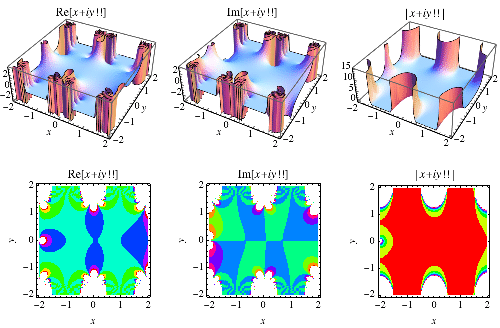The double factorial of a positive integer is a generalization of the usual factorial
defined by
 |
(1)
|
Note that ,
by definition (Arfken 1985, p. 547).
The origin of the notation appears not to not be widely known and is not mentioned
in Cajori (1993).
For ,
1, 2, ..., the first few values are 1, 1, 2, 3, 8, 15, 48, 105, 384, ... (OEIS A006882). The numbers of decimal digits in
for
, 1, ... are 1, 4, 80, 1285, 17831, 228289, 2782857, 32828532,
... (OEIS A114488).
The double factorial is implemented in the Wolfram Language as n!! or Factorial2[n].
The double factorial is a special case of the multifactorial.
The double factorial can be expressed in terms of the gamma function by
|
(2)
|
(Arfken 1985, p. 548).
The double factorial can also be extended to negative odd integers using the definition
|
(3)
| |||
|
(4)
|
for ,
1, ... (Arfken 1985, p. 547).
 |
Similarly, the double factorial can be extended to complex arguments as
|
(5)
|
There are many identities relating double factorials to factorials. Since
![(2n+1)!!2^nn!
=[(2n+1)(2n-1)...1][2n][2(n-1)][2(n-2)]...2·1
=[(2n+1)(2n-1)...1][2n(2n-2)(2n-4)...2]
=(2n+1)(2n)(2n-1)(2n-2)(2n-3)(2n-4)...2·1
=(2n+1)!,](/images/equations/DoubleFactorial/NumberedEquation4.svg) |
(6)
|
it follows that .
For
,
1, ..., the first few values are 1, 3, 15, 105, 945, 10395, ... (OEIS A001147).
Also, since
|
(7)
| |||
|
(8)
| |||
|
(9)
|
it follows that .
For
,
1, ..., the first few values are 1, 2, 8, 48, 384, 3840, 46080, ... (OEIS A000165).
Finally, since
![(2n-1)!!2^nn!
=[(2n-1)(2n-3)...1][2n][2(n-1)][2(n-2)]...2(1)
=(2n-1)(2n-3)...1][2n(2n-2)(2n-4)...2]
=2n(2n-1)(2n-2)(2n-3)(2n-4)...2(1)
=(2n)!,](/images/equations/DoubleFactorial/NumberedEquation5.svg) |
(10)
|
it follows that
|
(11)
|
For odd,
|
(12)
| |||
|
(13)
| |||
|
(14)
|
For even,
|
(15)
| |||
|
(16)
| |||
|
(17)
|
Therefore, for any ,
|
(18)
|
|
(19)
|
The double factorial satisfies the beautiful series
 |
(20)
| ||
 |
(21)
| ||
|
(22)
|
The latter gives rhe sum of reciprocal double factorials in closed form as
|
(23)
| |||
|
(24)
| |||
|
(25)
|
(OEIS A143280), where is a lower incomplete
gamma function. This sum is a special case of the reciprocal
multifactorial constant.
A closed-form sum due to Ramanujan is given by
![sum_(n=0)^infty(-1)^n[((2n-1)!!)/((2n)!!)]^3=[(Gamma(9/8))/(Gamma(5/4)Gamma(7/8))]^2](/images/equations/DoubleFactorial/NumberedEquation9.svg) |
(26)
|
(Hardy 1999, p. 106). Whipple (1926) gives a generalization of this sum (Hardy 1999, pp. 111-112).